Relationship of Cross Cultural Adaptability and Emotional Intelligence
新视野大学英语读写教程二作文

新视野下的跨文化交流:挑战与机遇In the ever-evolving global landscape, cross-cultural communication has become an integral part of our daily lives. As the world becomes increasingly interconnected,the need to understand and adapt to different cultural norms and practices becomes paramount. This is particularly relevant in the context of education, where the NewHorizons College English Reading and Writing Course Book II serves as a valuable tool for fostering cross-cultural understanding and proficiency.The readings in this textbook offer a diverse range of perspectives, allowing students to gain insights into different cultures and the challenges they pose in communication. One such challenge is the linguistic barrier, which often presents itself as a significant obstacle in cross-cultural interactions. Language is not just a toolfor communication; it is also a carrier of culture and values. Therefore, mastering the nuances of a language goes beyond mere linguistic proficiency; it involves understanding the cultural context and implications behind it.Another challenge lies in the interpretation of non-verbal cues, such as facial expressions, gestures, and spatial relations. These cues often carry significant cultural meanings and can vary widely across different cultures. For instance, what might be considered appropriate eye contact in one culture might be considered disrespectful in another. Similarly, gestures that are considered friendly and affable in one culture might be misinterpreted as offensive in another.Despite these challenges, cross-cultural communication also presents immense opportunities. It broadens our horizons, allowing us to gain a deeper understanding of the world and the people who inhabit it. By engaging with diverse cultures, we become more tolerant and empathetic, which in turn, fosters a more inclusive and harmonious society.Moreover, cross-cultural communication is crucial in today's globalized economy. Businesses and organizations increasingly rely on cross-cultural teams to collaborate and innovate. By understanding and adapting to different cultural norms, professionals can establish strongrelationships with their counterparts from different cultures, leading to successful outcomes and mutual growth. In conclusion, the New Horizons College English Reading and Writing Course Book II provides a valuable platform for exploring cross-cultural communication. It highlights the challenges and opportunities associated with cross-cultural interactions, encouraging students to develop a nuanced understanding of different cultures and the skills necessary for effective communication. As we navigate the increasingly globalized world, such understanding and proficiency in cross-cultural communication will be paramount in fostering mutual understanding, respect, and collaboration.**新视野下的跨文化交流:挑战与机遇**在全球化日益发展的今天,跨文化交流已成为我们日常生活中不可或缺的一部分。
英语论文 跨文化交际 跨文化交际的技巧 Cross-Cultural Communication Skills
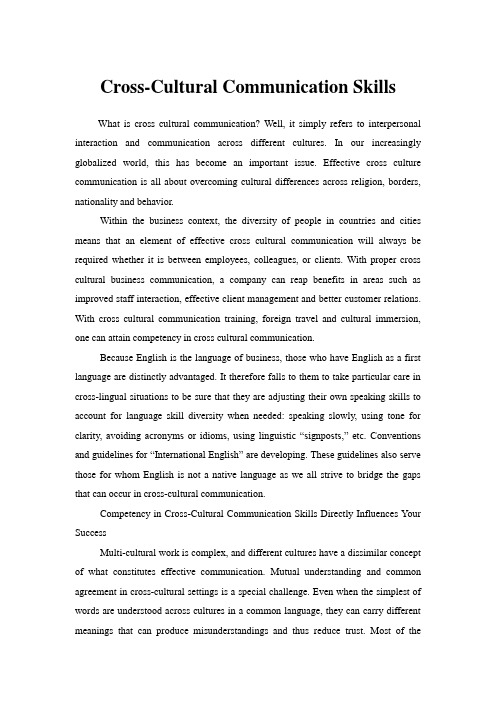
Cross-Cultural Communication SkillsWhat is cross cultural communication? Well, it simply refers to interpersonal interaction and communication across different cultures. In our increasingly globalized world, this has become an important issue. Effective cross culture communication is all about overcoming cultural differences across religion, borders, nationality and behavior.Within the business context, the diversity of people in countries and cities means that an element of effective cross cultural communication will always be required whether it is between employees, colleagues, or clients. With proper cross cultural business communication, a company can reap benefits in areas such as improved staff interaction, effective client management and better customer relations. With cross cultural communication training, foreign travel and cultural immersion, one can attain competency in cross cultural communication.Because English is the language of business, those who have English as a first language are distinctly advantaged. It therefore falls to them to take particular care in cross-lingual situations to be sure that they are adjusting their own speaking skills to account for language skill diversity when needed: speaking slowly, using tone for cl arity, avoiding acronyms or idioms, using linguistic “signposts,” etc. Conventions and guidelines for “International English” are developing. These guidelines also serve those for whom English is not a native language as we all strive to bridge the gaps that can occur in cross-cultural communication.Competency in Cross-Cultural Communication Skills Directly Influences Your SuccessMulti-cultural work is complex, and different cultures have a dissimilar concept of what constitutes effective communication. Mutual understanding and common agreement in cross-cultural settings is a special challenge. Even when the simplest of words are understood across cultures in a common language, they can carry different meanings that can produce misunderstandings and thus reduce trust. Most of thechallenges caused by cross-cultural clashes are the result of the failure by some or all parties involved to recognize and account for differences in culturally-based communication styles.Below are some guidelines to help improve your cross cultural communication skills.Cross cultural communications require the following:Listening skills. This is a key skill that many business personnel do not exercise enough. To avoid any cross cultural communication problems, attentive listening is critical to be able to understand meanings and empathize with the speaker.Speaking skills. Speaking well is not about accent, use of grammar and vocabulary or having the "gift of the gab" Rather, cross cultural communication is enhanced through positive speech such as encouragement, recognition or expressing opinions sensitively.Observation. To over any cross cultural communication barriers, one need to be more observant of people's dress, body language, interaction and behavior, as these details contain large amounts of cross cultural information.Patience. While there are times when cross cultural differences can be annoying and frustrating, patience is definitely a virtue in such cases. Through patience, respect can be won and cross cultural understanding will be enhanced.Flexibility. You must be open-minded and adaptable if you wish to achieve successful cross cultural communication. Understanding and addresses cross cultural differences can lead to a breakdown of cultural barriers which in turn lead to better communication and stronger trust between both parties.Following the 5 above-mentioned cross cultural communication needs will help to improve communication and pave the path towards stronger cross cultural relationships.。
你如何理解,跨文化交流竞争力,英语作文

你如何理解,跨文化交流竞争力,英语作文How Do You Understand Cross-Cultural Competitiveness?Have you ever wondered what it's like to visit or live in another country? It's so exciting to experience different cultures, try new foods, and meet people from around the world! But it can also be a little confusing and challenging at times. That's where cross-cultural competitiveness comes in.Cross-cultural competitiveness is all about being able to effectively communicate, understand, and adapt to different cultures. It means having an open mind, being respectful of differences, and being able to navigate cultural nuances. It's a really important skill to have in our globalized world.Let me give you an example. Imagine you're visiting Japan, and you go to a restaurant. In some cultures, it's considered rude to slurp your noodles or burp after a meal. But in Japan, slurping is actually a sign that you're enjoying your food, and a little burp shows you're full and satisfied! If you didn't know about these cultural differences, you might accidentally offend someone without meaning to.That's why cross-cultural competitiveness is so valuable. It helps you avoid misunderstandings and build stronger connections with people from diverse backgrounds.But cross-cultural competitiveness isn't just about knowing the customs and traditions of other cultures. It's also about being self-aware and understanding your own cultural biases and assumptions. We all have certain beliefs and values that shape how we see the world, and it's important to recognize that others may have different perspectives.For instance, in some cultures, it's considered impolite to make direct eye contact with elders or authority figures. But in other cultures, avoiding eye contact is seen as dishonest or disrespectful. If you're not aware of these differences, you might accidentally come across as rude or untrustworthy without meaning to.Another key aspect of cross-cultural competitiveness is being a good listener and observer. When you're interacting with someone from a different cultural background, pay attention to their body language, tone of voice, and the way they communicate. Don't make assumptions or jump to conclusions. Ask questions respectfully if you're unsure about something, and be open to learning.For example, in some cultures, it's considered polite to decline an offer or invitation the first few times it's extended. This might seem confusing or frustrating if you're not aware of this cultural norm. But if you take the time to listen and observe, you'll pick up on these subtle cues and be better able to navigate the situation.Cross-cultural competitiveness also involves being adaptable and flexible. You might need to adjust your communication style, personal space preferences, or even your sense of humor depending on the cultural context. It's about finding common ground and building bridges, rather than insisting that your own way is the right way.Imagine you're working on a group project with classmates from different cultural backgrounds. One of your teammates might prefer to communicate more directly and get straight to the point, while another might value building rapport and small talk before diving into the task at hand. Being cross-culturally competent means being able to adapt and find a middle ground that works for everyone.One of the best ways to build cross-cultural competitiveness is to immerse yourself in diverse environments. Attend cultural events, try new cuisines, or even learn a new language. The moreyou step outside of your comfort zone and engage with different cultures, the more your understanding and appreciation will grow.It's also important to be open-minded and non-judgmental. Different doesn't necessarily mean better or worse – it's just different. Embrace cultural diversity and recognize that there are often multiple valid perspectives and ways of doing things.Cross-cultural competitiveness isn't just about being polite or avoiding offending others (although that's certainly part of it). It's about building genuine connections, fostering mutual understanding, and creating a more inclusive and harmonious world.In today's interconnected global society, cross-cultural competitiveness is more important than ever. We're constantly interacting with people from diverse backgrounds, whether it's in our classrooms, neighborhoods, or online communities. Being able to navigate these cultural differences with sensitivity and respect is an invaluable skill.So the next time you encounter someone from a different cultural background, embrace the opportunity to learn and grow. Ask questions, listen with an open mind, and be willing to adapt and find common ground. Cross-cultural competitiveness isn'tjust a fancy term – it's a way of building bridges, fostering understanding, and making the world a little bit smaller and more connected.。
The Importance of Cross-Cultural Understanding
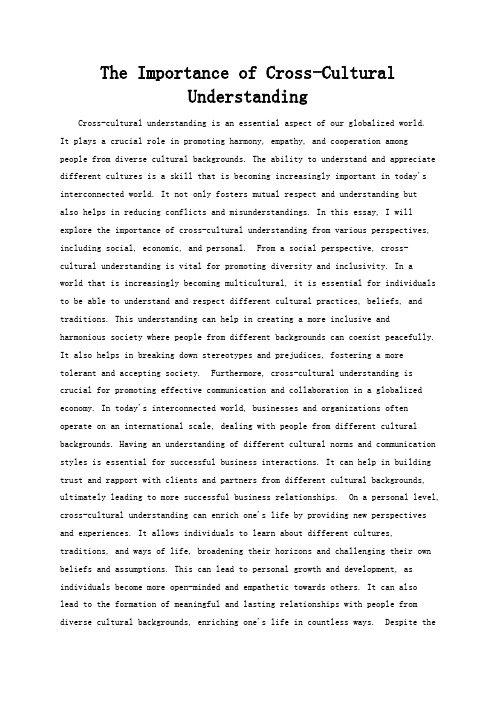
The Importance of Cross-CulturalUnderstandingCross-cultural understanding is an essential aspect of our globalized world.It plays a crucial role in promoting harmony, empathy, and cooperation amongpeople from diverse cultural backgrounds. The ability to understand and appreciate different cultures is a skill that is becoming increasingly important in today's interconnected world. It not only fosters mutual respect and understanding butalso helps in reducing conflicts and misunderstandings. In this essay, I will explore the importance of cross-cultural understanding from various perspectives, including social, economic, and personal. From a social perspective, cross-cultural understanding is vital for promoting diversity and inclusivity. In aworld that is increasingly becoming multicultural, it is essential for individuals to be able to understand and respect different cultural practices, beliefs, and traditions. This understanding can help in creating a more inclusive and harmonious society where people from different backgrounds can coexist peacefully. It also helps in breaking down stereotypes and prejudices, fostering a moretolerant and accepting society. Furthermore, cross-cultural understanding is crucial for promoting effective communication and collaboration in a globalized economy. In today's interconnected world, businesses and organizations often operate on an international scale, dealing with people from different cultural backgrounds. Having an understanding of different cultural norms and communication styles is essential for successful business interactions. It can help in building trust and rapport with clients and partners from different cultural backgrounds, ultimately leading to more successful business relationships. On a personal level, cross-cultural understanding can enrich one's life by providing new perspectives and experiences. It allows individuals to learn about different cultures, traditions, and ways of life, broadening their horizons and challenging their own beliefs and assumptions. This can lead to personal growth and development, as individuals become more open-minded and empathetic towards others. It can alsolead to the formation of meaningful and lasting relationships with people from diverse cultural backgrounds, enriching one's life in countless ways. Despite themany benefits of cross-cultural understanding, there are also challenges and barriers that can hinder its development. One of the main challenges is the presence of cultural stereotypes and prejudices, which can lead to misunderstandings and conflicts between people from different cultural backgrounds. These stereotypes are often perpetuated by the media and can lead to negative perceptions of certain cultures, hindering the development of cross-cultural understanding. Another barrier to cross-cultural understanding is the lack of exposure to different cultures. Many people may have limited opportunities to interact with individuals from different cultural backgrounds, leading to a lackof understanding and appreciation for diversity. This can be particularly challenging in homogenous societies where there is little diversity, making it difficult for individuals to develop cross-cultural understanding. In conclusion, cross-cultural understanding is essential for promoting harmony, empathy, and cooperation in our globalized world. It plays a crucial role in promotingdiversity and inclusivity, fostering effective communication and collaboration,and enriching one's personal life. While there are challenges and barriers to developing cross-cultural understanding, it is important for individuals and societies to actively work towards promoting it. By fostering mutual respect and understanding, we can create a more inclusive and harmonious world where people from diverse cultural backgrounds can coexist peacefully.。
跨文化交际的英文作文
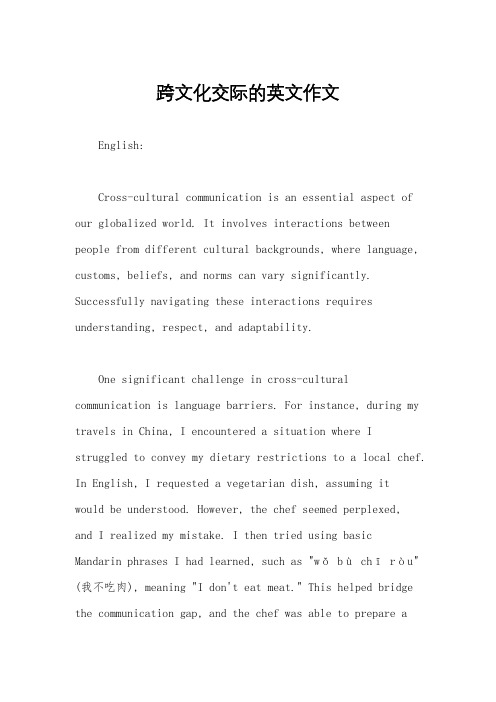
跨文化交际的英文作文English:Cross-cultural communication is an essential aspect of our globalized world. It involves interactions between people from different cultural backgrounds, where language, customs, beliefs, and norms can vary significantly. Successfully navigating these interactions requires understanding, respect, and adaptability.One significant challenge in cross-cultural communication is language barriers. For instance, during my travels in China, I encountered a situation where Istruggled to convey my dietary restrictions to a local chef. In English, I requested a vegetarian dish, assuming itwould be understood. However, the chef seemed perplexed,and I realized my mistake. I then tried using basic Mandarin phrases I had learned, such as "wǒ bù chī ròu" (我不吃肉), meaning "I don't eat meat." This helped bridge the communication gap, and the chef was able to prepare asuitable meal.Another aspect to consider is non-verbal communication. In many cultures, gestures, facial expressions, and body language convey meanings as much as words do. For example, a firm handshake is often seen as a sign of confidence and respect in Western cultures. However, in some Asian cultures, a softer handshake may be more appropriate, as a firm grip can be perceived as aggressive. Understanding these nuances is crucial for building rapport and avoiding misunderstandings.Moreover, cultural differences in communication styles can lead to misunderstandings. For instance, in some cultures, direct communication is valued, while in others, indirect communication is preferred to maintain harmony. During a business negotiation in Japan, I found that my straightforward approach was met with silence and nods, which I initially interpreted as agreement. However, upon reflection, I realized that my Japanese counterparts were being polite and non-confrontational, and their silence indicated they were considering my proposal rather thanagreeing outright.In conclusion, effective cross-cultural communication requires patience, empathy, and an open mind. Byrecognizing and respecting cultural differences in language, non-verbal cues, and communication styles, we can foster mutual understanding and build stronger relationshipsacross borders.中文:跨文化交际是我们全球化世界中至关重要的一部分。
英语作文跨文化能力的必要性
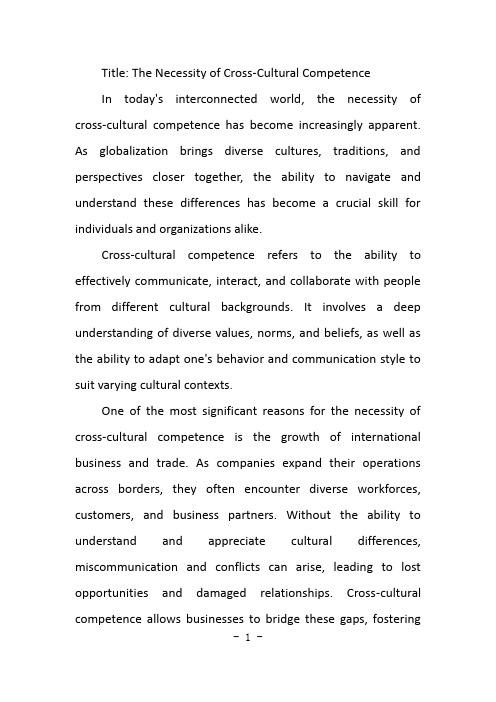
Title: The Necessity of Cross-Cultural CompetenceIn today's interconnected world, the necessity of cross-cultural competence has become increasingly apparent. As globalization brings diverse cultures, traditions, and perspectives closer together, the ability to navigate and understand these differences has become a crucial skill for individuals and organizations alike.Cross-cultural competence refers to the ability to effectively communicate, interact, and collaborate with people from different cultural backgrounds. It involves a deep understanding of diverse values, norms, and beliefs, as well as the ability to adapt one's behavior and communication style to suit varying cultural contexts.One of the most significant reasons for the necessity of cross-cultural competence is the growth of international business and trade. As companies expand their operations across borders, they often encounter diverse workforces, customers, and business partners. Without the ability to understand and appreciate cultural differences, miscommunication and conflicts can arise, leading to lost opportunities and damaged relationships. Cross-cultural competence allows businesses to bridge these gaps, fosteringstronger relationships and more effective collaborations.Moreover, cross-cultural competence is essential for personal and professional development. In a world where people from different cultures are constantly interacting, it is important to be able to empathize with others, respect their views, and contribute to meaningful dialogues. This not only enhances personal relationships but also opens up new opportunities for personal growth and professional advancement.Additionally, cross-cultural competence is vital for solving global challenges. Issues such as climate change, poverty, and conflict require a collaborative and coordinated effort from nations and individuals across the globe. Understanding and respecting diverse perspectives allows us to find common ground and develop more effective solutions to these pressing problems.However, achieving cross-cultural competence is not a straightforward task. It requires a continuous process of learning, reflection, and adaptation. We need to be open to new experiences, willing to question our own assumptions, and ready to embrace different ways of thinking and behaving. We should also seek out opportunities to interact with people fromdiverse cultures, such as participating in international exchange programs, volunteering in multicultural environments, or simply engaging in conversations with those who have different backgrounds.Moreover, organizations can play a pivotal role in fostering cross-cultural competence. They can provide training and resources to help employees develop the skills and knowledge needed to navigate diverse cultural contexts. They can also create inclusive work environments that encourage open communication and respect for different perspectives.In conclusion, the necessity of cross-cultural competence is undeniable in today's globalized world. It is not just a skill for international business or diplomacy but a fundamental requirement for effective communication and collaboration across all sectors and contexts. By developing cross-cultural competence, we can build stronger relationships, solve global challenges, and create a more inclusive and harmonious world.To enhance cross-cultural competence, individuals and organizations must make a concerted effort. This involves being proactive in seeking out opportunities to engage with diverse cultures, being open to learning and adapting, and fostering an environment of inclusivity and respect. As we continue tonavigate the complexities of the globalized world, cross-cultural competence will become an increasingly important asset for success and growth.In summary, cross-cultural competence is a crucial skill that enables us to effectively engage with the diverse world we live in. It is essential for personal and professional development, business success, and global cooperation. By cultivating this ability, we can bridge cultural divides, foster understanding and respect, and create a more interconnected and prosperous world.。
The Benefits of Cross-Cultural Exchange
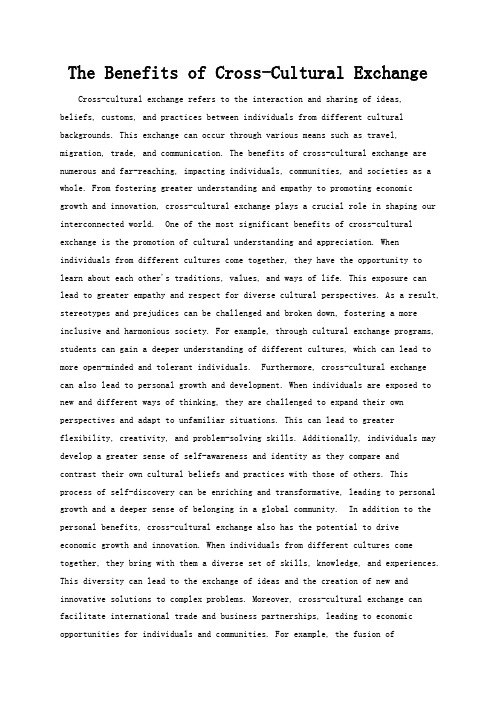
The Benefits of Cross-Cultural Exchange Cross-cultural exchange refers to the interaction and sharing of ideas, beliefs, customs, and practices between individuals from different cultural backgrounds. This exchange can occur through various means such as travel, migration, trade, and communication. The benefits of cross-cultural exchange are numerous and far-reaching, impacting individuals, communities, and societies as a whole. From fostering greater understanding and empathy to promoting economic growth and innovation, cross-cultural exchange plays a crucial role in shaping our interconnected world. One of the most significant benefits of cross-cultural exchange is the promotion of cultural understanding and appreciation. When individuals from different cultures come together, they have the opportunity to learn about each other's traditions, values, and ways of life. This exposure can lead to greater empathy and respect for diverse cultural perspectives. As a result, stereotypes and prejudices can be challenged and broken down, fostering a more inclusive and harmonious society. For example, through cultural exchange programs, students can gain a deeper understanding of different cultures, which can lead to more open-minded and tolerant individuals. Furthermore, cross-cultural exchange can also lead to personal growth and development. When individuals are exposed to new and different ways of thinking, they are challenged to expand their own perspectives and adapt to unfamiliar situations. This can lead to greater flexibility, creativity, and problem-solving skills. Additionally, individuals may develop a greater sense of self-awareness and identity as they compare andcontrast their own cultural beliefs and practices with those of others. This process of self-discovery can be enriching and transformative, leading to personal growth and a deeper sense of belonging in a global community. In addition to the personal benefits, cross-cultural exchange also has the potential to drive economic growth and innovation. When individuals from different cultures come together, they bring with them a diverse set of skills, knowledge, and experiences. This diversity can lead to the exchange of ideas and the creation of new and innovative solutions to complex problems. Moreover, cross-cultural exchange can facilitate international trade and business partnerships, leading to economic opportunities for individuals and communities. For example, the fusion ofdifferent culinary traditions in the food industry has led to the creation of new and exciting cuisines, driving economic growth and entrepreneurship. Another important benefit of cross-cultural exchange is the preservation and promotion of cultural heritage. As individuals from different cultures interact and share their traditions, there is a greater opportunity for the preservation of cultural practices and customs that may be at risk of being lost. Furthermore, cross-cultural exchange can lead to the revitalization of traditional art forms, music, and craftsmanship, ensuring that these cultural treasures are passed down tofuture generations. For example, the exchange of traditional dance and music between different cultures can lead to the preservation and promotion of these art forms on a global scale. Moreover, cross-cultural exchange can also have a positive impact on global peace and diplomacy. When individuals from different cultures come together in a spirit of mutual respect and understanding, it can help to bridge divides and promote peaceful coexistence. By fostering dialogue and cooperation between different cultural groups, cross-cultural exchange can contribute to the resolution of conflicts and the promotion of peace on both a local and global scale. For example, cultural exchange programs between countries can help to build trust and understanding, laying the foundation for diplomatic relations and cooperation. In conclusion, the benefits of cross-cultural exchange are vast and multifaceted, impacting individuals, communities, and societies in numerous ways. From fostering greater understanding and empathy to promoting economic growth and innovation, cross-cultural exchange plays a crucial role in shaping our interconnected world. By promoting cultural understanding and appreciation, driving personal growth and development, driving economic growth and innovation, preserving and promoting cultural heritage, and contributing to global peace and diplomacy, cross-cultural exchange has the power to create a more inclusive, harmonious, and prosperous global community. As we continue to navigate an increasingly interconnected world, it is essential to recognize and celebrate the many benefits of cross-cultural exchange.。
对跨文化能力的理解英语作文
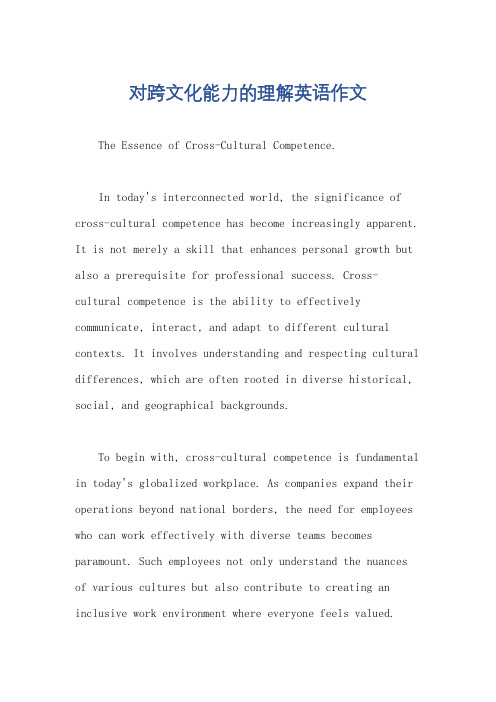
对跨文化能力的理解英语作文The Essence of Cross-Cultural Competence.In today's interconnected world, the significance of cross-cultural competence has become increasingly apparent. It is not merely a skill that enhances personal growth but also a prerequisite for professional success. Cross-cultural competence is the ability to effectively communicate, interact, and adapt to different cultural contexts. It involves understanding and respecting cultural differences, which are often rooted in diverse historical, social, and geographical backgrounds.To begin with, cross-cultural competence is fundamental in today's globalized workplace. As companies expand their operations beyond national borders, the need for employees who can work effectively with diverse teams becomes paramount. Such employees not only understand the nuances of various cultures but also contribute to creating an inclusive work environment where everyone feels valued.Communication is a crucial aspect of cross-cultural competence. It goes beyond mere language proficiency. It involves understanding non-verbal cues, such as body language and facial expressions, which often carry significant cultural meanings. For instance, certain gestures that might be considered friendly in one culture might be considered offensive in another. Cross-cultural competence requires one to be aware of these subtleties and adjust their communication style accordingly.Moreover, cross-cultural competence demands adaptability. When working in a multicultural environment, it is essential to be flexible and willing to learn. This involves being open to new ideas, practices, and ways of thinking. It also means being able to navigate complex social norms and protocols, which can vary significantly across cultures.Cultural awareness is another crucial component of cross-cultural competence. This involves understanding the values, beliefs, and behaviors that shape a particularculture. It means being sensitive to cultural differences and avoiding making assumptions or generalizations.Cultural awareness also involves understanding the impactof historical and societal factors on a culture's development.In addition to these, cross-cultural competencerequires conflict resolution skills. Differences in culture, values, and perspectives often lead to misunderstandingsand conflicts. It is essential to have the ability to manage these conflicts constructively, ensuring that theydo not escalate into larger problems. This involves active listening, empathy, and the ability to find common ground.Finally, cross-cultural competence is about creating a shared understanding and respect among diverse groups. It involves promoting cultural sensitivity and inclusivity, ensuring that everyone feels valued and respected. This, in turn, fosters a positive work environment where team members can collaborate effectively, leading to better outcomes and increased productivity.In conclusion, cross-cultural competence is anessential skill for anyone looking to succeed in today's globalized world. It involves understanding and respecting cultural differences, effective communication, adaptability, cultural awareness, conflict resolution skills, andfostering inclusivity. As we increasingly engage with diverse cultures, the need for cross-cultural competence becomes even more urgent. By developing these skills, wecan not only enhance our personal growth but alsocontribute to building a more inclusive and connected world.。
文化智力、自我效能感与跨文化适应——基于短期来华留学生的研究
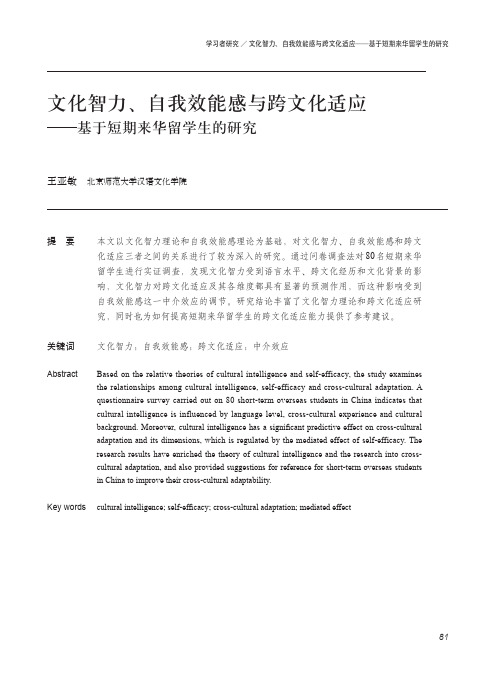
文化智力、自我效能感与跨文化适应——基于短期来华留学生的研究王亚敏 北京师范大学汉语文化学院提 要 本文以文化智力理论和自我效能感理论为基础,对文化智力、自我效能感和跨文化适应三者之间的关系进行了较为深入的研究。
通过问卷调查法对80名短期来华留学生进行实证调查,发现文化智力受到语言水平、跨文化经历和文化背景的影响,文化智力对跨文化适应及其各维度都具有显著的预测作用,而这种影响受到自我效能感这一中介效应的调节。
研究结论丰富了文化智力理论和跨文化适应研究,同时也为如何提高短期来华留学生的跨文化适应能力提供了参考建议。
关键词 文化智力;自我效能感;跨文化适应;中介效应Abstract Based on the relative theories of cultural intelligence and self-efficacy, the study examines the relationships among cultural intelligence, self-efficacy and cross-cultural adaptation. Aquestionnaire survey carried out on 80 short-term overseas students in China indicates thatcultural intelligence is influenced by language level, cross-cultural experience and culturalbackground. Moreover, cultural intelligence has a significant predictive effect on cross-culturaladaptation and its dimensions, which is regulated by the mediated effect of self-efficacy. Theresearch results have enriched the theory of cultural intelligence and the research into cross-cultural adaptation, and also provided suggestions for reference for short-term overseas studentsin China to improve their cross-cultural adaptability.Key words cultural intelligence; self-efficacy; cross-cultural adaptation; mediated effect一、引言随着“一带一路”倡议的不断推进和我国综合国力的提升,中外高校国际学术交流日益频繁,来华留学生的数量逐年增加。
英语教学中大学生跨文化交际能力培养研究
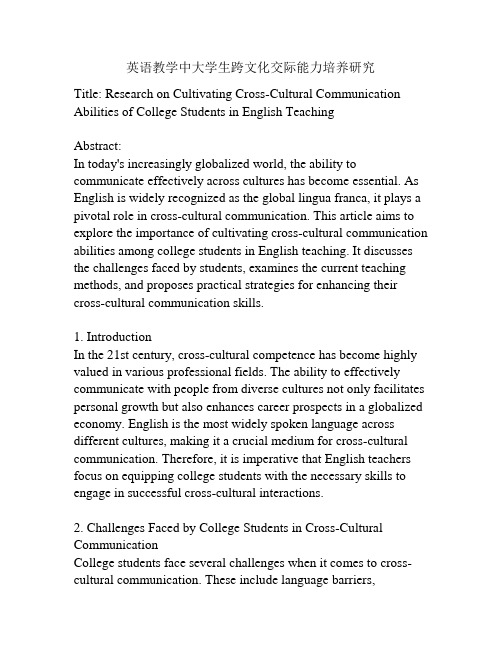
英语教学中大学生跨文化交际能力培养研究Title: Research on Cultivating Cross-Cultural Communication Abilities of College Students in English TeachingAbstract:In today's increasingly globalized world, the ability to communicate effectively across cultures has become essential. As English is widely recognized as the global lingua franca, it plays a pivotal role in cross-cultural communication. This article aims to explore the importance of cultivating cross-cultural communication abilities among college students in English teaching. It discusses the challenges faced by students, examines the current teaching methods, and proposes practical strategies for enhancing their cross-cultural communication skills.1. IntroductionIn the 21st century, cross-cultural competence has become highly valued in various professional fields. The ability to effectively communicate with people from diverse cultures not only facilitates personal growth but also enhances career prospects in a globalized economy. English is the most widely spoken language across different cultures, making it a crucial medium for cross-cultural communication. Therefore, it is imperative that English teachers focus on equipping college students with the necessary skills to engage in successful cross-cultural interactions.2. Challenges Faced by College Students in Cross-Cultural CommunicationCollege students face several challenges when it comes to cross-cultural communication. These include language barriers,unfamiliarity with cultural norms and practices, and a lack of exposure to diverse cultures. Consequently, students often struggle to navigate cultural differences, leading to misunderstandings and ineffective communication. It is essential for educators to understand these challenges and address them appropriately.3. Current Teaching MethodsTraditional English teaching methods often focus on language proficiency alone, neglecting the cultural aspects of communication. The emphasis is typically placed on grammar, vocabulary, and pronunciation, while cultural competence is treated as secondary. This approach fails to adequately prepare students for real-world cross-cultural interactions. To address this limitation, it is crucial to integrate culture-specific content and activities into the English curriculum.4. Strategies to Enhance Cross-Cultural Communication Abilities 4.1 Cultural Immersion Programs: Encourage students to participate in cultural immersion programs, such as study abroad programs, to expose themselves to different cultures. This immersive experience can greatly enhance their understanding of cultural differences and improve their ability to communicate effectively.4.2 Intercultural Learning Activities: Incorporate intercultural learning activities into language classes to promote cultural understanding. This can include role-play exercises, group discussions on cultural topics, and presentations on cultural practices. Encouraging students to actively engage with cross-cultural content will foster cultural sensitivity and effectivecommunication skills.4.3 Incorporating Multimedia Resources: Utilize authentic resources, such as videos, movies, and music, from different cultures to expose students to diverse linguistic and cultural contexts. Discussing these resources in class and encouraging students to reflect on the cultural nuances will help develop their intercultural competence.4.4 Collaboration with Native English Speakers: Establish partnerships or collaborations with native English speakers from different cultural backgrounds. Through regular communication and interaction, students can gain insights into different cultures, practice their English skills, and develop cross-cultural communication abilities.4.5 Cultural Awareness Workshops: Conduct workshops that focus on enhancing cultural awareness and sensitivity. These workshops can explore topics like cultural stereotypes, non-verbal communication, and adapting communication styles in different cultural contexts. Such workshops encourage self-reflection and equip students with essential skills for communicating across cultures.5. ConclusionEffective cross-cultural communication abilities are vital for college students to thrive in an increasingly interconnected world. English teachers should move beyond traditional language-teaching methods and focus on incorporating cultural aspects into their instruction. By implementing strategies such as culturalimmersion programs, intercultural learning activities, multimedia resources, collaborations with native English speakers, and cultural awareness workshops, educators can effectively cultivate cross-cultural communication abilities among college students. This will empower them to navigate cultural differences confidently and contribute positively to a global society.。
跨文化交流与理解包容高中生英语作文
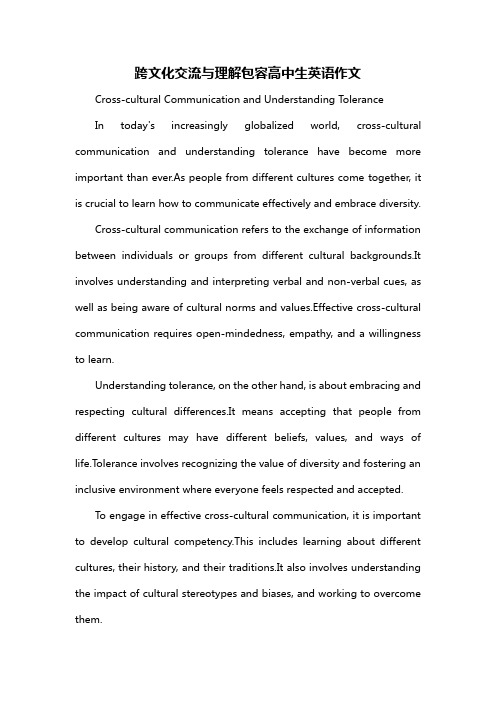
跨文化交流与理解包容高中生英语作文Cross-cultural Communication and Understanding ToleranceIn today's increasingly globalized world, cross-cultural communication and understanding tolerance have become more important than ever.As people from different cultures come together, it is crucial to learn how to communicate effectively and embrace diversity.Cross-cultural communication refers to the exchange of information between individuals or groups from different cultural backgrounds.It involves understanding and interpreting verbal and non-verbal cues, as well as being aware of cultural norms and values.Effective cross-cultural communication requires open-mindedness, empathy, and a willingness to learn.Understanding tolerance, on the other hand, is about embracing and respecting cultural differences.It means accepting that people from different cultures may have different beliefs, values, and ways of life.T olerance involves recognizing the value of diversity and fostering an inclusive environment where everyone feels respected and accepted.To engage in effective cross-cultural communication, it is important to develop cultural competency.This includes learning about different cultures, their history, and their traditions.It also involves understanding the impact of cultural stereotypes and biases, and working to overcome them.In addition, building relationships with people from different cultures can help foster understanding and tolerance.This can be done through participation in cultural exchange programs, attending multicultural events, or simply getting to know individuals from different backgrounds.By embracing cross-cultural communication and understanding tolerance, we can create a more harmonious and inclusive society.We can break down barriers, reduce conflicts, and promote mutual respect and understanding.In conclusion, as we navigate the challenges of a diverse and interconnected world, cross-cultural communication and understanding tolerance are essential skills.They enable us to build bridges between cultures, fostering mutual respect and understanding.By embracing diversity and promoting inclusivity, we can create a better future for all.。
对于跨文化理解的英语作文
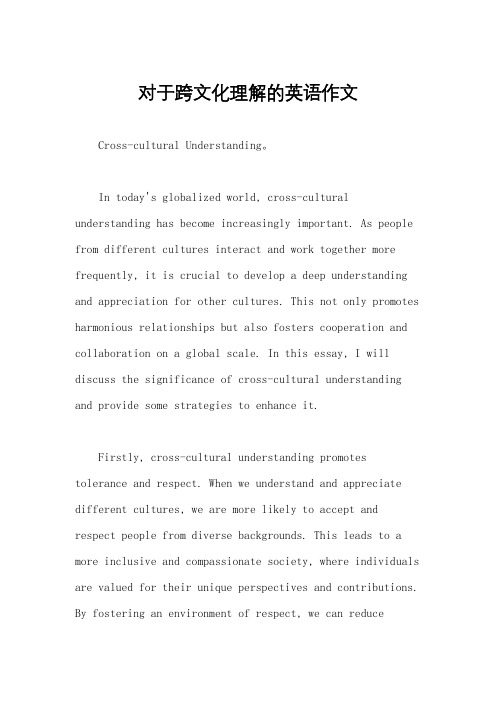
对于跨文化理解的英语作文Cross-cultural Understanding。
In today's globalized world, cross-cultural understanding has become increasingly important. As people from different cultures interact and work together more frequently, it is crucial to develop a deep understanding and appreciation for other cultures. This not only promotes harmonious relationships but also fosters cooperation and collaboration on a global scale. In this essay, I will discuss the significance of cross-cultural understanding and provide some strategies to enhance it.Firstly, cross-cultural understanding promotes tolerance and respect. When we understand and appreciate different cultures, we are more likely to accept and respect people from diverse backgrounds. This leads to a more inclusive and compassionate society, where individuals are valued for their unique perspectives and contributions. By fostering an environment of respect, we can reducediscrimination, prejudice, and conflicts that arise from cultural misunderstandings.Secondly, cross-cultural understanding enhances communication and collaboration. Effective communication is essential in all aspects of life, whether it is in personal relationships, business interactions, or international diplomacy. When we understand the cultural nuances and communication styles of others, we can communicate more effectively and avoid misunderstandings. This isparticularly important in the business world, where successful collaborations often depend on understanding the cultural norms and expectations of partners from different countries.Furthermore, cross-cultural understanding enriches our personal growth and broadens our horizons. By learning about different cultures, we gain new perspectives, ideas, and ways of thinking. This allows us to challenge our own biases and stereotypes, and develop a more open-minded and inclusive worldview. Additionally, exposure to different cultures can inspire creativity and innovation, as weincorporate diverse ideas and approaches into our own lives and work.To enhance cross-cultural understanding, several strategies can be employed. Firstly, education plays a crucial role. Schools and universities should incorporate cross-cultural education into their curriculum, teaching students about different cultures, histories, and traditions. This will help students develop empathy and respect for other cultures from a young age. Additionally, cultural exchange programs and study abroad opportunities can provide firsthand experiences and immersion indifferent cultures, allowing individuals to develop a deeper understanding and appreciation.Secondly, fostering intercultural communication is essential. Organizations and communities should create opportunities for people from different cultures tointeract and engage in dialogue. This can be achieved through cultural festivals, language exchange programs, or community events that celebrate diversity. By encouraging people to share their experiences and perspectives, we canbridge the gap between cultures and build meaningful connections.Lastly, promoting cultural sensitivity and awareness is crucial. This involves being mindful of cultural differences and adapting our behavior accordingly. It is important to avoid making assumptions or generalizations about a particular culture and instead approach each individual with an open mind. By being respectful and considerate of different cultural practices and customs, we can create a more inclusive and understanding society.In conclusion, cross-cultural understanding is vital in our increasingly interconnected world. It promotes tolerance, enhances communication and collaboration, and enriches personal growth. By incorporating cross-cultural education, fostering intercultural communication, and promoting cultural sensitivity, we can build a more inclusive and harmonious global community. Let us embrace diversity and strive to understand and appreciate the richness of different cultures.。
相互理解与跨文化交流的重要性英语作文
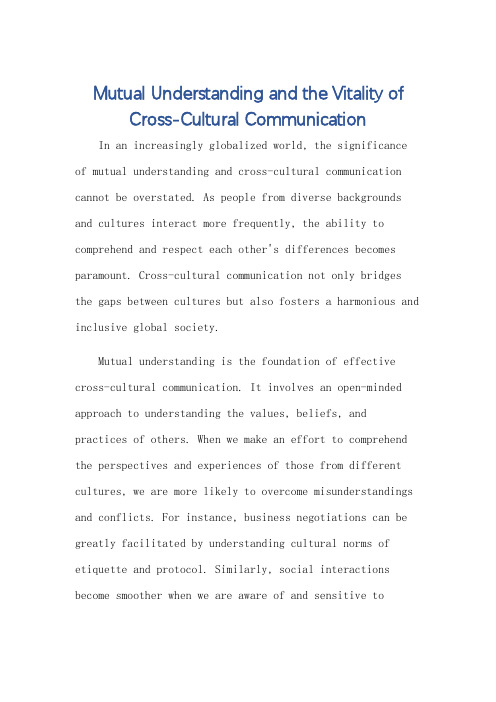
Mutual Understanding and the Vitality of Cross-Cultural CommunicationIn an increasingly globalized world, the significance of mutual understanding and cross-cultural communication cannot be overstated. As people from diverse backgrounds and cultures interact more frequently, the ability to comprehend and respect each other's differences becomes paramount. Cross-cultural communication not only bridges the gaps between cultures but also fosters a harmonious and inclusive global society.Mutual understanding is the foundation of effective cross-cultural communication. It involves an open-minded approach to understanding the values, beliefs, and practices of others. When we make an effort to comprehend the perspectives and experiences of those from different cultures, we are more likely to overcome misunderstandings and conflicts. For instance, business negotiations can be greatly facilitated by understanding cultural norms of etiquette and protocol. Similarly, social interactions become smoother when we are aware of and sensitive tocultural differences in communication styles and social customs.Cross-cultural communication, in turn, enhances mutual understanding. Through interactive exchanges, people have the opportunity to share their stories, experiences, and perspectives. Such exchanges not only broaden our horizons but also promote empathy and respect. In education, for instance, cross-cultural communication is crucial for cultivating globally aware students who are able to navigate diverse environments and contribute effectively to the global community.Moreover, cross-cultural communication is vital for addressing the challenges of cultural conflict and misunderstanding. In a world where cultural diversity is the norm, conflicts and misunderstandings are inevitable. However, through constructive dialogue and respectful communication, we can mitigate these tensions and move towards a more unified and harmonious global community. The media, in particular, plays a crucial role in promoting cross-cultural understanding by providing platforms for diverse voices and perspectives.In conclusion, mutual understanding and cross-cultural communication are inextricably linked and vital for promoting harmony and progress in our globalized world. By fostering an environment of respect, openness, and包容性(inclusivity), we can create a world where diversecultures can coexist and thrive, leading to a more interconnected and understanding global society.**相互理解与跨文化交流的重要性**在全球化的世界中,相互理解与跨文化交流的重要性不言而喻。
相互理解与跨文化交流的重要性英语作文
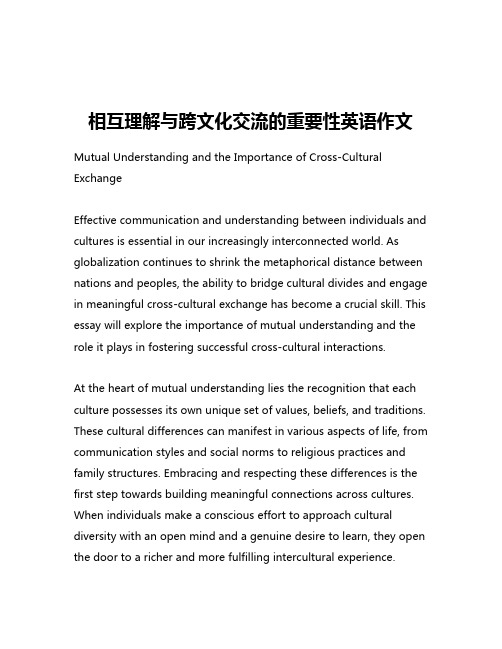
相互理解与跨文化交流的重要性英语作文Mutual Understanding and the Importance of Cross-Cultural ExchangeEffective communication and understanding between individuals and cultures is essential in our increasingly interconnected world. As globalization continues to shrink the metaphorical distance between nations and peoples, the ability to bridge cultural divides and engage in meaningful cross-cultural exchange has become a crucial skill. This essay will explore the importance of mutual understanding and the role it plays in fostering successful cross-cultural interactions.At the heart of mutual understanding lies the recognition that each culture possesses its own unique set of values, beliefs, and traditions. These cultural differences can manifest in various aspects of life, from communication styles and social norms to religious practices and family structures. Embracing and respecting these differences is the first step towards building meaningful connections across cultures. When individuals make a conscious effort to approach cultural diversity with an open mind and a genuine desire to learn, they open the door to a richer and more fulfilling intercultural experience.One of the primary benefits of mutual understanding is its ability to facilitate effective communication. In a cross-cultural setting, misunderstandings can easily arise due to differences in language, nonverbal cues, and cultural references. By developing an awareness and appreciation for these nuances, individuals can navigate such challenges more effectively, leading to more productive and satisfying interactions. This is particularly important in professional contexts, where successful collaboration and negotiation often hinge on the ability to communicate clearly and respectfully across cultural boundaries.Moreover, mutual understanding fosters empathy and compassion. When we make the effort to understand the perspectives and lived experiences of those from different cultural backgrounds, we cultivate a deeper sense of empathy and a greater appreciation for the diversity of the human experience. This, in turn, can help to break down stereotypes, reduce prejudice, and promote more inclusive and equitable societies. By fostering a culture of mutual understanding, we can create an environment where individuals feel valued, respected, and able to contribute their unique talents and perspectives.The benefits of cross-cultural exchange extend beyond the interpersonal realm, as it can also have a positive impact on broader societal and global issues. In an increasingly interconnected world,tackling complex challenges such as climate change, global health crises, and international conflicts requires collaborative efforts that transcend national and cultural boundaries. By engaging in cross-cultural dialogue and collaboration, individuals and organizations can pool their diverse knowledge, resources, and perspectives to develop more comprehensive and effective solutions to these pressing global concerns.Furthermore, the exchange of ideas, customs, and traditions that occurs through cross-cultural interactions can lead to cultural enrichment and innovation. When individuals from different backgrounds come together, they have the opportunity to learn from one another, share their unique cultural contributions, and potentially create new and innovative ways of thinking and doing. This cross-pollination of ideas can spur creative breakthroughs, foster new areas of artistic expression, and contribute to the overall cultural vibrancy of our interconnected world.In conclusion, the importance of mutual understanding and cross-cultural exchange cannot be overstated. By embracing cultural diversity, developing empathy and compassion, and engaging in meaningful dialogue and collaboration, we can build stronger, more inclusive, and more resilient communities. As we navigate the challenges and opportunities of our globalized world, the ability to bridge cultural divides and foster cross-cultural understanding willbe essential in shaping a more just, equitable, and prosperous future for all.。
跨文化笔相容英语作文
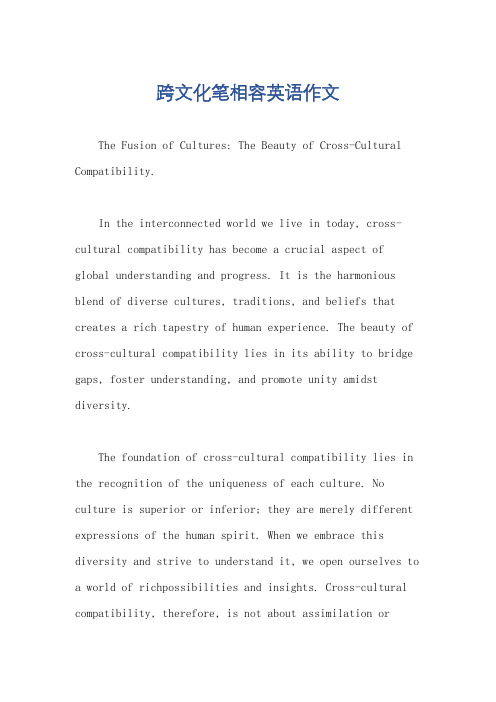
跨文化笔相容英语作文The Fusion of Cultures: The Beauty of Cross-Cultural Compatibility.In the interconnected world we live in today, cross-cultural compatibility has become a crucial aspect of global understanding and progress. It is the harmonious blend of diverse cultures, traditions, and beliefs that creates a rich tapestry of human experience. The beauty of cross-cultural compatibility lies in its ability to bridge gaps, foster understanding, and promote unity amidst diversity.The foundation of cross-cultural compatibility lies in the recognition of the uniqueness of each culture. No culture is superior or inferior; they are merely different expressions of the human spirit. When we embrace this diversity and strive to understand it, we open ourselves to a world of richpossibilities and insights. Cross-cultural compatibility, therefore, is not about assimilation orhomogenization but about mutual respect and accommodation.One of the most visible manifestations of cross-cultural compatibility is in the realm of food. The融合 of cuisines from around the globe has created a global cuisine that is both diverse and delicious. From the sizzling streets of Asia to the bustling markets of Europe, the world's cuisines have converged,交换ing flavors and techniques. This cross-cultural exchange has not only broadened our palates but has also deepened our understanding of other cultures.In the arts and entertainment industry, cross-cultural compatibility has given rise to a vibrant global culture. Movies, music, and fashion have all become platforms for cultural exchange. Artists from different backgrounds have collaborated,融合 their talents and perspectives to create works that are both innovative and inclusive. This cross-cultural collaboration has not only enriched our cultural landscape but has also broken down barriers and fostered understanding.Moreover, cross-cultural compatibility is crucial in today's interconnected world, where businesses and economies are increasingly global. Successful companies understand that to thrive in the global market, they must embrace diversity and leverage the strengths of different cultures. Cross-cultural teams bring a多样性 of perspectives and ideas that can drive innovation and create competitive advantages.However, achieving cross-cultural compatibility is not always easy. Language barriers, cultural misunderstandings, and ethnocentrism can all pose challenges. It requires an open mind, patience, and a willingness to learn and adapt. It also requires active listening and the ability to communicate effectively in different cultural contexts.In conclusion, cross-cultural compatibility is a powerful force that can bring people together, break down barriers, and create a more inclusive and understanding world. It is about embracing diversity, fostering understanding, and celebrating our common humanity. As we continue to navigate the globalized world, let us rememberthat cross-cultural compatibility is not just a nice-to-have but a necessity for building a more harmonious and prosperous future.。
英语作文跨文化能力训练

英语作文跨文化能力训练Cross-Cultural Training: Enhancing Intercultural Competence。
Introduction:In today's globalized world, intercultural competence has become an essential skill for individuals and organizations. Cross-cultural training plays a crucial role in developing this competence, enabling individuals to navigate diverse cultural environments effectively. This essay explores the importance of cross-cultural training, its benefits, and provides practical strategies for individuals to enhance their intercultural competence.Body:1. Importance of Cross-Cultural Training:Cross-cultural training equips individuals with thenecessary knowledge, skills, and attitudes to interact and communicate effectively across cultures. It helps individuals understand the nuances of different cultures, including their values, beliefs, and communication styles. By gaining this understanding, individuals can avoid misunderstandings, misinterpretations, and cultural faux pas, fostering positive and productive relationships with people from diverse cultural backgrounds.2. Benefits of Cross-Cultural Training:a) Enhanced Communication: Cross-cultural training enables individuals to develop effective communication strategies that transcend cultural barriers. It equips them with the ability to adapt their communication style, use appropriate non-verbal cues, and understand cultural context, leading to improved intercultural communication.b) Increased Cultural Sensitivity: By undergoing cross-cultural training, individuals become more aware of their own cultural biases and assumptions. This increased self-awareness allows them to approach cultural differences withempathy and respect, fostering a more inclusive and harmonious environment.c) Improved Problem-Solving: Cross-cultural training enhances individuals' problem-solving skills inmulticultural settings. It equips them with the ability to think critically, consider multiple perspectives, and find creative solutions that respect cultural diversity.d) Strengthened Teamwork: In diverse teams, cross-cultural training promotes effective teamwork. It helpsteam members understand and appreciate each other'scultural backgrounds, leading to increased collaboration, productivity, and innovation.3. Strategies to Enhance Intercultural Competence:a) Cultural Immersion: Actively seeking opportunitiesto immerse oneself in different cultures can be a powerful way to enhance intercultural competence. This may include traveling, participating in cultural exchange programs, or engaging with individuals from diverse cultural backgrounds.b) Developing Cultural Knowledge: Reading books, articles, and watching documentaries about differentcultures can provide valuable insights into their customs, traditions, and values. This knowledge forms the foundation for understanding and appreciating cultural differences.c) Cultural Sensitivity Training: Participating in workshops or courses that focus on cultural sensitivity and diversity can help individuals develop the necessary skills to navigate cultural differences effectively. Thesetrainings often include interactive exercises, case studies, and role-plays to simulate real-life cross-cultural scenarios.d) Building Relationships: Actively seekingopportunities to build relationships with individuals from different cultures fosters cross-cultural understanding and empathy. Engaging in open and respectful conversations, actively listening, and asking questions can deepen one's understanding of different perspectives.e) Reflective Practice: Regularly reflecting on one's own cultural biases, assumptions, and experiences in cross-cultural interactions is essential for personal growth. This self-reflection helps individuals identify areas for improvement and develop strategies to enhance their intercultural competence.Conclusion:Cross-cultural training is a vital component in developing intercultural competence. By equipping individuals with the necessary knowledge, skills, and attitudes, it enhances communication, cultural sensitivity, problem-solving, and teamwork in multicultural settings. Through strategies such as cultural immersion, knowledge development, sensitivity training, relationship-building, and reflective practice, individuals can continuously enhance their intercultural competence and contribute to a more inclusive and harmonious global society.。
跨文融情长的英语作文

Crosscultural communication is a vital aspect of our increasingly globalized world. It involves the exchange of information,ideas,and emotions between individuals or groups from different cultural backgrounds.Effective communication in such scenarios requires a deep understanding of cultural nuances,empathy,and respect for diversity.Understanding Cultural DifferencesThe first step in crosscultural communication is to recognize and appreciate the differences that exist between cultures.This includes understanding the values,beliefs, customs,and social norms of the culture in question.For instance,in some cultures, direct eye contact is a sign of respect,while in others,it may be considered confrontational or aggressive.Language and Communication StylesLanguage is a powerful tool for communication,but it is not the only one.Nonverbal cues,such as body language and gestures,can also convey meaning.However,these cues can have different interpretations across cultures.For example,the thumbsup gesture is generally seen as positive in Western cultures,but it can be offensive in some Middle Eastern countries.Building RapportEstablishing rapport is crucial in crosscultural interactions.This can be achieved by showing genuine interest in the other persons culture,asking openended questions,and actively listening to their responses.Its also important to be aware of ones own cultural biases and to approach conversations with an open mind.Adapting Communication StrategiesAdapting ones communication style to suit the cultural context is essential for effective crosscultural communication.This might involve adjusting the pace of conversation,the level of formality,or the directness of ones speech.For example,in cultures that value highcontext communication,such as Japan,messages are often conveyed indirectly through subtle cues rather than explicit statements.Cultural Sensitivity and RespectBeing culturally sensitive means being aware of and respectful towards the feelings, beliefs,and practices of others.This includes avoiding stereotypes,being mindful of onesown cultural assumptions,and being willing to learn from others.Respectful communication involves acknowledging and validating the other persons perspective, even when it differs from ones own.Overcoming Communication BarriersBarriers to crosscultural communication can arise from language differences,cultural misunderstandings,or personal biases.Overcoming these barriers requires patience, flexibility,and a willingness to clarify and seek understanding.It may also involve using interpreters or translation tools when necessary.The Role of TechnologyIn todays digital age,technology plays a significant role in facilitating crosscultural communication.Social media,video conferencing,and translation apps can help bridge gaps between cultures and make communication more accessible.However,its important to remember that technology cannot replace the human touch and the personal connection that comes with facetoface interactions.ConclusionIn conclusion,crosscultural communication is a complex and rewarding process that enriches our understanding of the world and fosters global harmony.By being aware of cultural differences,adapting communication strategies,and showing respect and sensitivity,we can navigate the challenges of crosscultural interactions and build meaningful connections with people from diverse backgrounds.。
六级英语作文范文
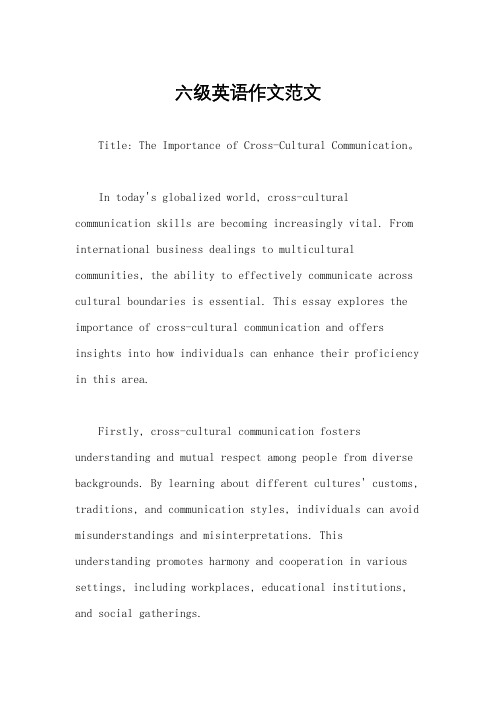
六级英语作文范文Title: The Importance of Cross-Cultural Communication。
In today's globalized world, cross-cultural communication skills are becoming increasingly vital. From international business dealings to multicultural communities, the ability to effectively communicate across cultural boundaries is essential. This essay explores the importance of cross-cultural communication and offers insights into how individuals can enhance their proficiency in this area.Firstly, cross-cultural communication fosters understanding and mutual respect among people from diverse backgrounds. By learning about different cultures' customs, traditions, and communication styles, individuals can avoid misunderstandings and misinterpretations. This understanding promotes harmony and cooperation in various settings, including workplaces, educational institutions, and social gatherings.Secondly, proficient cross-cultural communicationskills are crucial for success in today's global economy. With businesses expanding their operations across borders, professionals must navigate cultural differences to build successful partnerships and ventures. Effective cross-cultural communication enables companies to bridge cultural gaps, negotiate agreements, and adapt marketing strategies to resonate with diverse audiences.Moreover, cross-cultural communication enhances personal growth and empathy. When individuals interact with people from different cultural backgrounds, they gain new perspectives and insights into alternative ways of thinking and living. This exposure fosters empathy and open-mindedness, leading to personal growth and enriched interpersonal relationships.To enhance cross-cultural communication skills, individuals can take several proactive steps. Firstly, they should educate themselves about different cultures' norms, values, and communication styles. This can be achievedthrough reading, attending cultural events, or engaging in intercultural exchanges. Secondly, individuals should cultivate empathy and a willingness to listen actively to others' perspectives without judgment. Thirdly, practicing effective communication techniques such as clarity, active listening, and nonverbal communication awareness can significantly improve cross-cultural interactions.Furthermore, language proficiency plays a vital role in cross-cultural communication. While English has become a global lingua franca, learning additional languages can greatly facilitate communication with people from non-English-speaking backgrounds. Language learning demonstrates respect for other cultures and can deepen cross-cultural understanding.In conclusion, cross-cultural communication skills are indispensable in today's interconnected world. By fostering understanding, facilitating successful business interactions, and promoting personal growth, proficient cross-cultural communication enhances individuals' lives and contributes to a more harmonious global society.Through education, empathy, and language proficiency, individuals can develop the necessary skills to navigate cultural differences effectively and build meaningful connections across borders.。
跨文化融合英语作文模板
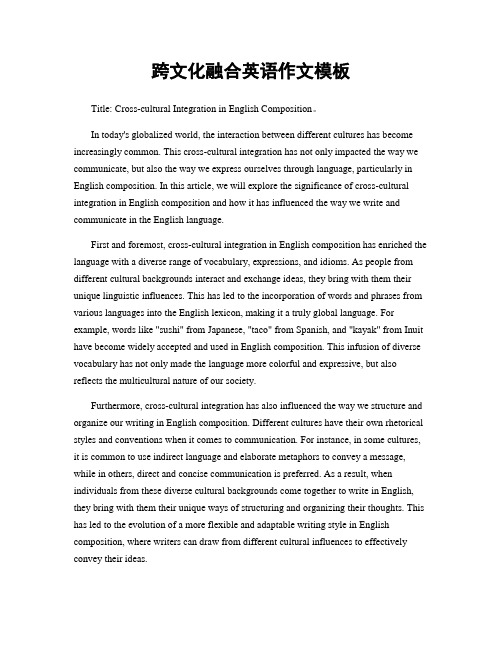
跨文化融合英语作文模板Title: Cross-cultural Integration in English Composition。
In today's globalized world, the interaction between different cultures has become increasingly common. This cross-cultural integration has not only impacted the way we communicate, but also the way we express ourselves through language, particularly in English composition. In this article, we will explore the significance of cross-cultural integration in English composition and how it has influenced the way we write and communicate in the English language.First and foremost, cross-cultural integration in English composition has enriched the language with a diverse range of vocabulary, expressions, and idioms. As people from different cultural backgrounds interact and exchange ideas, they bring with them their unique linguistic influences. This has led to the incorporation of words and phrases from various languages into the English lexicon, making it a truly global language. For example, words like "sushi" from Japanese, "taco" from Spanish, and "kayak" from Inuit have become widely accepted and used in English composition. This infusion of diverse vocabulary has not only made the language more colorful and expressive, but also reflects the multicultural nature of our society.Furthermore, cross-cultural integration has also influenced the way we structure and organize our writing in English composition. Different cultures have their own rhetorical styles and conventions when it comes to communication. For instance, in some cultures, it is common to use indirect language and elaborate metaphors to convey a message, while in others, direct and concise communication is preferred. As a result, when individuals from these diverse cultural backgrounds come together to write in English, they bring with them their unique ways of structuring and organizing their thoughts. This has led to the evolution of a more flexible and adaptable writing style in English composition, where writers can draw from different cultural influences to effectively convey their ideas.In addition, cross-cultural integration has also played a significant role in shaping the themes and topics that are explored in English composition. As writers from different cultural backgrounds share their experiences and perspectives, they bring with them a rich tapestry of stories, traditions, and beliefs. This has led to a broadening of the themes and topics that are addressed in English composition, encompassing a wide range of cultural, social, and historical perspectives. For example, writers from diverse cultural backgrounds may draw inspiration from their own heritage to explore themes such as identity, migration, and belonging, adding depth and diversity to the literary landscape of English composition.Moreover, cross-cultural integration has also influenced the way we approach language and communication in English composition. As individuals from different cultural backgrounds come together to write in English, they bring with them their own unique ways of thinking and expressing themselves. This has led to a more inclusive and open-minded approach to language and communication, where diverse perspectives and voices are valued and celebrated. In turn, this has fostered a more inclusive and global community of writers who are able to engage with and appreciate the diverse range of linguistic and cultural influences in English composition.In conclusion, cross-cultural integration has had a profound impact on English composition, enriching the language with a diverse range of vocabulary, expressions, and perspectives. This has not only made the language more vibrant and dynamic, but has also fostered a more inclusive and open-minded approach to communication. As we continue to navigate the complexities of a globalized world, the significance of cross-cultural integration in English composition will only continue to grow, shaping the way we write and communicate in the English language for years to come.。
跨文化交际-跨文化适应

• 跨文化适应的心理失衡论 • 把文化震荡当做心智健康的失序(mental health disorder)来处理。 • 缺乏行为技能(behavioral skills)所致。 ❀跨文化适应的悲叹论(grief) ❀跨文化适应的宿命论(fatalism) ❀跨文化适应的训练与治疗(training and therapy)
• 这些例子,俯拾皆是, 是跨文化交际过程中 常见的事件与当事人的反应。
第一节 跨文化适应的本质与意义
• 跨文化适应(intercultural adaptation / intercultural adjustment)泛指对一个新文化环境 逐渐感到贴切或相称的过程。 • 跨文化适应的研究,通常着重在居于异国的人们, 适应新文化过程所产生的矛盾、焦躁、烦恼与痛 苦的心理冲击(psychological impact),又被称 为文化震荡(cultural shock)。 • 一个阶段 / 等同于
❀角色震荡(role shock) • 指个人因环境的更换,原来的个人地位突然消失 了的失落感。
❀转换震荡(transition shock) • 指为了配合新环境做出了巨大改变时,所承受的 压力与痛苦。 • 或叫文化疲乏(cultural fatigue),压力适应 (adjustment press)
•
文化认同的特征
1. 自我认知的中枢(central to the self sense) • 文化认同的启动是由自我声明(avowal)或他 人归因(ascription)所导致。 • 自我声明是对人宣称“我是某某人”或“我是 什么”;他人归因指一个人的认同是别人认为 他是什么,他就自认为是什么而形成的。
跨文化适应技巧论 • 只要习得目标国文化的交际技巧,旅居人的适应 过程就会一帆风顺。 • Kohls • Gudykunst & Kim • Chen:信息技巧(message skills),行为弹性 (behavior flexibility),互动经营 (interaction management),社交技巧 (social skills) • 跨文化交际能力 (intercultural communication competence)
- 1、下载文档前请自行甄别文档内容的完整性,平台不提供额外的编辑、内容补充、找答案等附加服务。
- 2、"仅部分预览"的文档,不可在线预览部分如存在完整性等问题,可反馈申请退款(可完整预览的文档不适用该条件!)。
- 3、如文档侵犯您的权益,请联系客服反馈,我们会尽快为您处理(人工客服工作时间:9:00-18:30)。
1Pre-publication – please do not reproduceThe Relationship of Cross Cultural Adaptabilityand Emotional IntelligenceCROSS CULTURAL ADAPTABILITYApril 2, 2008Judith Meyers, Psy.D.Associate Clinical Professor,Department of Psychiatry, University of California at San DiegoRichard Lewak, Ph.D.Private PracticeRonald Stolberg, Ph.D.California School of Professional Psychology at Alliant International UniversityJoanna Savarese-Levine, MACalifornia School of Professional Psychology, at Alliant International UniversityA measure of cross-cultural adaptability, the Cross Cultural Adaptability Inventory (CCAI), was administered along with measures of personality and psychopathology, ego strength, emotional intelligence and interpersonal relating styles to 205 applicants to a reality T.V. show that required cross-cultural resilience. The results of the study show convergent validity between the CCAI and measures of ego strength, emotional control, emotional intelligence and mental health. CCAI discriminate validity was revealed by the negative correlations between measures of psychopathology and cultural adaptability. The results show that cross-cultural adaptability is related to mental health, emotional resilience, attachment, and emotional intelligence.Six key words: MMPI-II, Resilience, Emotional Intelligence, CCAI, Culture Shock,Cross-Cultural Adaptability InventoryThe Relationship of Cross Cultural Adaptability and Emotional IntelligenceCROSS CULTURAL ADAPTABILITYApril 2, 2008The Cross-Cultural Adaptability Inventory (CCAI) (Kelley and Meyers, 1995) was developed to enhance the assessment of cross-cultural adaptability. The authors identified four personality dimensions that were related to successful cross-cultural adaptation. These dimensions comprise the four scales of the CCAI: Emotional Resilience (ER),Flexibility/Openness (FO), Perceptual Acuity (PAC), and Personal Autonomy (PA). Recently, the construct of emotional intelligence, a measure of emotional resilience, has been identified by cross-cultural scholars as an important component of successful cross-cultural adaptability (Cherbosque, Gardenswartz and Rowe, 2005; Tang, 2001). Cross cultural adaptability involves effective stress management, and therefore should be correlated with ego strength, another construct describing effective functioning under stress. Additionally, an absence of mental illness should be predictive of good cross cultural adaptability, though little research has been done specifically addressing this issue. A goal of this study was to confirm that the CCAI correlates with these aspects of cross-cultural adaptability.THEORIES OF CROSS-CULTURAL ADAPTATIONCulture shock, cross-cultural effectiveness and emotional intelligenceCulture shockCross-cultural adaptation theory began in the 1950s when Lysgaard proposed the “U” shaped curve theory of adaptation. According to this theory the lowest point on the “U” reflects the most difficult phase of adjustment. Following the initial enthusiastic period coined the “honeymoon phase” the dip is then followed by gradual adaptation, hence the resemblance to a “U” curve.The actual term “culture shock” is attributed to Oberg (1960). He conceptualized culture shock as the emotional response to cultural differences. Culture shock involves the loss of acquired emotional meaning and patterns of interpersonal interactions. It is also a result of the fatigue from constant adaptation to interpersonal differences, suggesting that it is similar to Selye’s “stress response” (Selye, et al. 1976). Selye discussed the Exhaustion Stage of the General Adaptation Syndrome, when one’s defenses break down in the face of stimulus overload. Others have viewed culture shock as a transition (Bennett, 1977), and pathological mourning (Garza-Guerrero, 1974) for one’s abandoned society.Cross-Cultural AdaptabilityCross-cultural adaptability and cross-cultural effectiveness are current terms which describe the relative effectiveness of individuals in dealing with adaptation to foreign cultures. Researchers have recognized that cultural adaptability varies amongst sojourners, and is dependant on a host of variables with interpersonal factors consistently being cited as of primary importance. For example Furnham and Bochner (1986) defined cultural adaptability as the ability to negotiate new situations and respond effectively to the intensity of emotional experiences. Gardner (1962) thought that cultural adaptability was associated with the ability to be a “universal communicator.” An individual with this skill possesses an unusual degree of psychological integration, perhaps another way of saying they reveal a low degree of neuroticism. He thought that this type of individual was extroverted, empathic, and had strong needs for affiliation. In addition, Gardner described the culturally resilient individual as having a value system which “values all men.” Ruben (1976) discussed both the need for empathy and tolerance for ambiguity as important factors in successful cultural adaptability. Cui and Awa (1992) agreed that cross-cultural success involved empathy, flexibility, patience, role flexibility, tolerance for ambiguity and the ability to establish and maintain relationships.Emotional IntelligenceThere are a number of links between the constructs of cross-cultural adaptability and emotional intelligence. Researchers in both fields agree that social and emotional skills are highly important variables in a person’s ability to successfully problem-solve. Mayer and Salovey (1997) described an ability model of emotional intelligence that centers on a person’s skill in recognizing emotional information and using that information to carry out abstract reasoning tasks. Social perceptiveness, empathy and a realistic emotional response to life’s vicissitudes can be as important to success in life as the ability to solve, for example, mathematical problems. According to Mayer and Salovey, emotional intelligence involves the “abilities to perceive, appraise and express emotion; to access and generate feelings when they facilitate thought; to understand emotion and emotional knowledge; and to regulate emotions to promote emotional and intellectual growth” (Mayer & Salovey, 1997, p. 10).An alternative conceptualization of emotional intelligence posits that emotionalintelligence is a social and emotional skill that results in successful relationships. It involves interpersonal and intrapersonal sensitivity, impulse control, optimism, and empathy for oneself and others (Goleman, 1995; Bar-On, 1997b, 2000). Bar-On conceptualized subsets of skills that were involved in intrapersonal functioning, interpersonal relationships, stress management, and mood regulation. He developed a self-report measure of Emotional Intelligence called the Bar-On EQI (Bar-On, 1997a).Cherbosque, Gardenswartz, and Rowe (2005) expanded the definition of emotional intelligence by incorporating the capacity for cultural adaptation into their construct. According to their model, the emotional ability to “feel, understand, articulate, manage and apply the power of emotions to interactions across lines of cultural difference” is a critical aspect of emotional intelligence. The EID model of emotional intelligence consists of four constructs: Affirmative Introspection, the introspective ability to understand one’s reaction to others; Self-Governance, the ability to maintain a positive attitude and self-control in the face of upsetting emotions; Intercultural Literacy, the ability to empathize with other’s cultural rules, norms and values; and Social Architecting, self-control and self-discipline in the service of building productive relationships.The CCAI and Emotional IntelligenceThe CCAI (Kelley and Meyers, 1995) was developed as a self-scoring training instrument designed to give feedback to the individual about his or her potential for cross-cultural effectiveness. Initially five constructs were developed from a review of the cross cultural literature and a polling of a panel of cross-cultural experts. Then the scales were refined using least-squares factor analysis and principal components extractions with varimax rotation. Factor scores were computed from these analyses, and correlations among items, scale scores, and between the principal components factors and the new scales were computed. The five factors were collapsed into four.The first factor of the CCAI is Emotional Resilience (ER) which consists of eighteen questions measuring a person’s ability to handle stressful feelings and bounce back from setbacks. The items tap issues relating to the ability to tolerate ambiguity, a sense of humor, a high positive self-regard and effectiveness dealing with new people and situations.The second factor of the CCAI is Flexibility/Openness (FO) a fifteen item scalemeasuring tolerance towards others. The items tap issues relating to flexibility with new people, ideas and experiences.The third factor of the CCAI is Perceptual Acuity(PAC). It is a ten item scale most closely associated with empathy. The items on this factor relate to an individual’s ability to read non-verbal cues and to understand behavior outside the context of a familiar culture.The fourth factor of the CCAI is Personal Autonomy(PA). It is comprised of seven items. It was initially designed to assess the strength of a person’s values, beliefs and personal identity. However, the results are often modified by gender, past cross-cultural experience, cultural values (i.e. collectivism v. independence) and the overall Flexibility/Openness score.The CCAI has been used in various research studies as a measure of cross-cultural effectiveness. The findings have shown that the CCAI correlates with impression management, (Montaglini and Giacalone, 1998), and empathy and social-emotional skills (Tang, 2001). All of the preceding constructs have been described as components of the construct of emotional intelligence (Bar-On, 1997a; Goleman, 1995).The issue of concurrent and predictive validity of the CCAI was explored in two studies assessing international students (Ward, Berno, and Main, 2000). One study revealed that emotional resilience and flexibility were related to fewer psychological and sociocultural adaption problems, while perceptual acuity and personal autonomy were associated with fewer sociocultural difficulties. In the second study, emotional resilience was found to be the strongest predictor of psychological wellbeing and perceptual acuity was the key factor in sociocultural adaptation. When psychological and sociocultural adaptation is used as the criterion variables, there is strong evidence for the concurrent validity of the CCAI. The authors concluded it was a reliable and valid instrument for assessing traits and abilities required for cross-cultural adaptation. The predictive validity as measured by re-entry scores was not established.The CCAI is also recognized as having utility for use in organizations to establish baseline information or assessment for international assignments (Landis, Bennett, and Bennett, 2004). There is also agreement in the literature that the CCAI reflects the skills, attitudes, and abilities that contribute to intercultural adjustments both in terms of cultural transition and job performance (Ward, Bochner, and Furnham, 2001).Tang (2001) explored the relationship between emotional intelligence and cross-cultural adaptability using the CCAI as a measure of cross-cultural effectiveness. She defined emotionalintelligence as empathy, communications of emotions and regulation of mood, and found that these abilities correlated with cross-cultural adaptability.The purpose of this study was to determine if there is a relationship between cross-cultural adaptability, emotional intelligence, ego strength and an absence of psychopathology. Emotional Intelligence was measured by the Bar-On Emotional Quotient Inventory (EQI) (Bar-On, 2000). Ego strength was measured by the Ego Strength (Es) scale of the Minnesota Multiphasic Personality Test 2 (MMPI-2) (Butcher et al., 1989). Psychopathology was measured by elevations on the individual scales of the MMPI-2. We hypothesized that cross culturally adaptive individuals would exhibit good ego strength and would lack psychopathology. We also hypothesized a correlation with emotional intelligence.METHODThe study consisted of 205 applicants to a reality T.V. show who would need to demonstrate cross-cultural travel abilities as well as cross-cultural problem solving skills. Participants were administered the Minnesota Multiphasic Personality Inventory-2 (MMPI 2), The Fundamental Interpersonal Relations Orientation-Behavior (FIRO-B), The Cross Cultural Adaptability Inventory (CCAI), and the Bar-On Emotional Quotient Inventory (EQI). This assessment battery was chosen to measure mental health, interpersonal relations, emotional intelligence and cross-cultural adaptability.The Cross Cultural Adaptability Inventory (CCAI) is a fifty question self-report self-scoring instrument designed to give feedback regarding an individual’s capacity for a successful cross-cultural adjustment. The instrument is scored using a six point Likert scale and derives scores on four dimensions, described earlier.The Fundamental Interpersonal Relations Orientation – Behavior Test (FIRO-B) (Shultz, 1989), consists of fifty-four items and examines two aspects of three dimensions of social or interpersonal needs. The two aspects are Expressed Behavior, how a person behaves or acts towards others, and Wanted Behavior, how a person desires to be treated by others. The three dimensions are: Inclusion, desiring being with people in general; Affection, measuring the need to be close to people; and Control, measuring the need to take control, or allow others to do so. The six expressed and wanted scores’ split-half reliability ranges from 0.93 to 0.94 (Schutz, 1978).The MMPI-2 is a 567 item true/false questionnaire. It provides a measure of personality and psychopathology. It was first published in 1943 and was revised in 1989. It consists of several validity scales, measuring test taking attitudes, and 10 original clinical scales measuring a range of psychopathologies and personality structures. It is the most widely used personality test in the world and its validity and reliability is well documented (Friedman, Lewak, Nichols, and Webb, 2001).The Bar-On Emotional Quotient Inventory (EQI)(Bar-On, 2000) measures the construct of emotional intelligence. It consists of 133 questions that yield an overall emotional quotient with a mean of 100 and a standard deviation of 15. There are five Composite Scales and 15 subscales. The EQI is based on 19 years of research by Dr. Reuven Bar-On and has been tested on over 48,000 individuals worldwide.ParticipantsParticipants for the study were 205 individuals, for whom there were complete assessment protocols, who had originally applied as teams of two. They were made up of friends, partners, married couples, siblings and parent/children combinations recruited by a television network to participate in a travel realty T.V. show The study participants were contestant applicants from five seasons of the show The sample consisted of 103 men with an average age of 34.9, with a range of 21-69 years old, and 102 women, with an average age of 32.5, with a range of 18-67 years old. Of the participants, 11% graduated high school, 32% finished some college and 56% graduated college.As part of the screening process, the applicants were interviewed and assessed by two of the authors. In all, data from 205 applicants, who included the actual competitors, were used and analyzed in this study.RESULTSThe results of the study reveal that the CCAI total score correlates negatively (r= -0.294, p< .001) with Welsh’s (A) Anxiety Scale of the MMPI-2, a measure of maladjustment. The CCAI total score is positively correlated (r= 0.377, p< .001) with extraversion as measured by lower scores on Scale 0 (Si) scale of the MMPI-2, and positively correlated (r= 0.327, p< .001) with the Correction (K) scale, a measure of impression management and emotional control.The data also reveals that cross-cultural adaptability (CCAI total score) is positively correlated (r= 0.426, p< .001) with the EQ total score, a measure of emotional intelligence. Further, the absence of mental illness, positive interpersonal skills, a desire to relate to others, and a capacity to manage stress well are all associated with cross-cultural adaptability as indicated by the convergent validity between scales of the MMPI and the CCAI. For example, Emotional Resilience (ER) correlates with “low neuroticism” on the MMPI-2, as measured by significant negative correlations with Depression (D), Social Introversion (Si), psychological distress as measured by the scale Infrequency (F), Welsh Anxiety (W-A), Anxiety (ANX), Anger (ANG), Low Self-Esteem (LSE), and Type A personality (TPA). There was also a significant positive correlation with Correction (K) and Ego Strength (ES). Several important scales and their relationships are described below:The K (Correction) ScaleK is a validity scale on the MMPI-2 that measures conscious and unconscious defensiveness (Friedman et al, 2000; Caldwell, 1976). It correlates positively with socio-economic status, education and ego strength (Friedman, Levak, Nichols &Webb, 2000). K measures a person’s capacity to appropriately modulate emotional expressiveness, which can be a result of both unconscious and conscious factors. It reflects a person’s ability to “put their best foot forward” and to approach life’s stressors with poise and control. While the K scale can be elevated due to unconscious emotional constriction, it is also a measure of a person’s purposeful attempt to look emotionally healthy and resilient.This latter component of the K scale is also known as Positive Impression Management. Studies have shown that the ability to successfully “look good” in the face of stress and to have the resilience necessary to create the right impression, has been correlated with cross-cultural success of business managers (Montagliana and Giacalone, 1998). Elevated K scores are also associated with healthy self-esteem (Caldwell, 1976; Nichols et al. 1989), a capacity to deal effectively with stress and an ability to maintain emotional equilibrium in the face of emotional turmoil. Additionally, The K scale, as a measure of ego strength, measures emotional stability and positive self-esteem.The ER and FO scales of the CCAI positively correlated at 0.304 (p<.001) and 0.335(p<.001) respectively with the K scale, suggesting that they measure a mixture of positiveimpression management and emotional control and poise. The ER and FO scales appear to be measuring some of the same traits or constructs. The total CCAI score correlates at 0.327 with K. This suggests that the CCAI as a whole, measures to some degree the same personality traits as the K scale, that is, ego strength, impression management and emotional stability.The Welsh Anxiety (A) ScaleThe theory that cross-cultural adaptability is associated with good mental health has been explored in the above paragraphs. The Anxiety, or Welsh A scale, on the MMPI-2 is a measure of general distress. The scale items reflect anxiety, disturbed thinking, dysphoria, discouragement, inferiority feelings and general maladjustment, all symptoms that would predict poor adaptation to stressful situations (Friedman, et al., 2000). Since the Welsh Anxiety scale on the MMPI-2 is negatively correlated with the K scale at -0.718, the negative correlations with the CCAI scales ER at -0.327; FO at -0.282; and the Total CCAI at -0.294 are consistent. The results suggest that the CCAI is a measure of emotional control and resilience, and confirm the view in the literature that mental health and cross-cultural adaptability are related.Scale 0 (Si: Social Introversion)Scale 0 on the MMPI-2, is a measure of social introversion with high scores reflecting social introversion. It is negatively correlated with CCAI scales ER at -0.422 and FO at -0.337, as well as the CCAI Total Score at -0.377. This suggests that a need for social interaction is associated with the CCAI total score and the two CCAI scales measuring flexibility and emotional resilience. It confirms the assumption that shyness would be negative for cross-cultural adaptability. In a new cultural environment, withdrawal from people is not likely to accelerate the learning curve of adaptability. On the other hand, extroverted people are likely to be open to new ideas and be emotionally resilient, which presents more opportunities to be rewarded by others.Scale 0 ( Si scale) was developed by Drake (1946) to measure introversion and extroversion, a normal individual difference variable with high heritability. This scale is correlated with general maladjustment and dysphoric distress, as well as feelings of inadequacy. It is not a measure of the pure construct of introversion and extroversion, as it is saturated with maladjustment content. As Nichols (and colleagues, 1989) points out “it is sensitive to a patternof malaise not readily reflected on the other MMPI-2 scales- a blend of shyness, self-consciousness, and discomfort in group situations with a broad range of psychological distress; including dysphoric mood, tension, anxiety and fearfulness; problems with cognition, physical vulnerability; convictions of inefficacy, incapacity, incompetence ….and a nagging, ambivalent and unstable quality of alienation from others ….” (p. 195). It is a very noteworthy finding that the Si scale correlates significantly and negatively with the CCAI scales ER, FO and total CCAI scale at -0.442, -0.337 and -0.337 respectively. It gives insight into the behaviors and psychological factors that impede cross-cultural adaption. It goes beyond the concepts of introversion/extraversion to illuminate that psychological well-being in addition to interpersonal skills are involved in cross-cultural adaption.CCAI and Interpersonal RelationshipsFundamental Interpersonal Relations Orientation-Behavior (FIRO-B)The FIRO-B, is a measure of interpersonal relating styles measuring an individual’s need for affection, control, and inclusion. The Total CCAI score correlated 0.309 with the Expressed Affection (EA) scale on the FIRO-B. The EA scale measures the tendency for an individual to be friendly and direct in expressing affection to others.Caruso, Mayer, and Salovey, (2002) found a significant correlation on the FIRO-B between affection, both expressed and wanted, and a measure of emotional intelligence, the MEIS (Mayer, Salovey, and Caruso, 2002). The Affection scale measures a person’s warmth and friendliness, particularly in an intimate context, coined Expressed Affection. It also measures a person’s desire for closeness and attachment toward others, known as Wanted Affection. High scorers readily express their affection, and others see them as warm and expressive.The correlation of the EA scale with the CCAI total score suggests that being a warm expressive person may aid in cross-cultural adaptation. The moderate correlation between EA and the total CCAI score contrasts with the Wanted Affection (WA), which only correlates with the Total CCAI at 0.193., which while significant is low. The WA scale measures an individual’s need for affection from others, thus high scorers seek out affectional bonds. More research needs to be done in this area to investigate the role of attachment theory in cross-cultural adjustment.The Bar-On Emotional Quotient Inventory (EQI)The EQI test measures emotional intelligence with an emphasis on psychological wellbeing (Bar-On, 2000). It consists of a number of scales that are broken down into sub-scales with face valid names. The Intrapersonal scale measures how well a person deals with intra-psychic issues. Its subscales include Self- Regard, Emotional Self-Awareness, Assertiveness and Independence. The Interpersonal Scale consists of three subscales: Empathy, Social Responsibly and Interpersonal Relationships. The Adaptability Scale has two subscales called Flexibility and Problem-Solving. The Stress Management scale has two subscales: Impulse Control and Stress Tolerance, while the General Mood scale has two subscales: Optimism and Happiness.The correlation between the Total EQI score and the Total CCAI Score is 0.426 (p<.001). This confirms the connection between emotional intelligence and cross cultural adaptability. The total CCAI Score correlates with the EQI subscale Empathy at 0.442 (p<.001). The high Empathy correlation with the overall score on the CCAI suggests the importance of this skill in cross-cultural communications. It also indicates that the CCAI has utility as a measure of interpersonal sensitivity.CONCLUSIONThe results of this study conforms with the theoretical literature that cross-cultural adaptability is related to extroversion, emotional poise and control, warmth, empathy and stress tolerance. These attributes have also been labeled as aspects of emotional intelligence, and as an extension of that, this study also suggests that emotional intelligence is related to cross-cultural adaptability.Cross-cultural adaptability can now be assessed using measures of emotional intelligence, as well as the CCAI. Emotional factors clearly play a significant role in cross-cultural adjustment, confirming the link between emotional intelligence and cross-cultural adaptability postulated by Tang (2001). These findings also support the training model of a tool called Emotional Intelligence and Diversity (EID), which emphasizes the role of social intelligence in training for cultural adaptation.There are implications for the use of the CCAI. The ER subscale of the CCAI appears to be a measure of freedom from psychological distress and emotional resilience. The positivecorrelations with some of he MMPI-2 scales also shed light on the success factors in cross-cultural adaptability: ego strength, extroversion, positive self-esteem, and the ability to create a good impression, regardless of whether the impetus to do so comes from conscious role-playing or genuine warmth and stress tolerance.The correlation of the CCAI with the EQI suggests the CCAI is a good measure of emotional intelligence as the CCAI and emotional intelligence are correlated. This has implications for training. Developing an individual’s capacity for empathy, emotional resilience, effective emotional expression and interpersonal skills can improve intercultural functioning. The research also suggests there are certain personality types that are inherently suited for the challenges of cultural adaptability. Nonetheless, this study suggests that individuals can be taught the coping strategies that comprise the core of emotional intelligence. By training an individual in emotional intelligence, a person can increase their effectiveness in dealing with people from other cultures.The results also call into question a popular trend in cross-cultural training to address only the developmental stages of cross-cultural sensitivity, without considering psychological and emotional factors (Bennett, 1986). This study underscores the need to address emotional and social factors, not just the cognitive understanding of cultural differences.BIBLIOGRAPHYBar-On, R. (1997a). The Bar-On Model of Emotional-Social Intelligence. University of Texas Medical Branch.Bar-On, R. (1997b) The Bar-On Emotional Quotient Inventory (EQ-i): A Test of Emotional Intelligence. Toronto, Canada. Multi-Health Systems.Bar-On, R. (2000). Emotional and social intelligence: Insights from the Emotional Quotient Inventory (EQ-i). In Reuven Bar-On and James D.A. Parker (Eds.), Handbook of emotional intelligence. San Francisco: Jossey-Bass.Bennett, J.M. (1977). "Transition Shock: Putting Culture Shock in Perspective." In Nemi C. Jain (Ed.), International and Intercultural Communication Annual 4:45- 52.Bennett, M.F. (1986). A developmental approach to training for intercultural sensitivity. Internation Journal of Intercultural Relations 10(2): 179-95.Bochner, S. (1982). The social psychology of cross-cultural relations, in Bochner, S. (ed.), Cultures in Contact: Studies in cross-cultural interaction, Oxford, Pergamon.Butcher, J.D., Dahlstrom, W.G., Graham, J.R., Tellegen, A., & Kaemmer, B. (1989). MMPI-2: Manual of administration and scoring. Minneapolis: University of Minnesota Press.Caldwell, A.B. (1976, January). MMPI profile types. Paper presented at the 11th Annual MMPI Workshop and Symposium. Minneapolis, MN.Caruso, D.R., Mayer, J.D., Salovey, P. (2002). Relation of an Ability Measure of Emotional Intelligence to Personality. Journal of Personality Assessment, 79(2), 306-320.Cherbosque, J., Gardenswartz, L., and Rowe, A. (2005), Emotional Intelligence and Diversity Series, Emotional Intelligence and Diversity Institute. Los Angeles, CA.Cui, G. & Awa, N.E. (1992). Measuring intercultural effectiveness: An integrative approach. International Journal of Intercultural Relations. 16, 311-328.Drake, L. E. (1946). A social I.E. scale for the Minnesota Multiphasic Personality Inventory. Journal of Applied Psychology, 30.Friedman, A. F., Lewak, R., Nichols, D. S., & Webb, J. T. (2000). Psychological Assessment with the MMPI-2 (2nd ed.): Lawrence Erlbaum Associates, Inc.Furnham, A. & Bochner, S. (1986).Culture shock: Psychological reactions to unfamiliar environments. London: Methuen.Gardner, G.H., (1962). Cross-cultural communication. Journal of Social Psychology, 58,。
